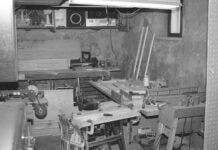Dial and digital indicators (left and top) can’t be beat for precision linear measurement. But for squaring up mill vises, “dialing in” lathe parts (aka adjusting concentricity), dial test indicators (right) are the workhorses of the machine shop.
Scope out any machine shop and you’ll find two basic types of indicators: dial indicators, which have a telescoping spindle, and test indicators, which (usually) have a smaller dial face and a pivoting stem. Although both are similar in form, particularly with respect to the dial face or digital readout, their respective duties in the shop are distinctly different. Dial indicators are for measuring, and test indicators are for—you guessed it—testing!
While the focus of this column is test indicators, some discussion of dial indicators is necessary to put test indicators in perspective. Dial indicators are accurate only when the spindle stroke is perpendicular to the object being measured. The readout “indicated” is the linear displacement of the spindle. You can, of course, use a dial indicator at an angle other than perpendicular, but the readout will not accurately represent the feature being measured due to cosine error. Cosine error also occurs with test indicators, but as we’ll see, the compact size, versatility of the articulating stem (versus the telescoping spindle), and the general method of using test indicators (for checking, not measuring), are reasons to use a test indicator instead of a dial indicator for many jobs.
Compared to typical dial indicators, which might have a range of zero to 1/2 inch, zero to one inch (the most common), or zero to two inches, test indicators have a very small “measuring” range: usually around 0.050 of an inch.
This test indicator features a pivoting mounting post (left) plus dovetail rails (A and B). The arrows around the measuring stem show the angle adjustability and measuring range.
Every indicator has some sort of mounting arrangement. Dial indicators usually have interchangeable backs to facilitate the attachment of various accessories such as a magnetic base or articulating arm. Test indicators might have a pivoting mounting post or dovetail rails, or both.
The key feature that makes the test indicator so versatile is the clutching stem. This allows you to adjust it to whatever angle you need and also protects the indicating mechanism from overtravel.
Using a test indicator to square a vise. Note the dial reading “suggests” the left side is about 0.005-inch forward of the right side.
Squaring up a vise or fixture on a milling machine is probably the most common application of a test indicator. To do this, mount a test indicator securely in the quill, in either a collet or a chuck. Position the vise or reference edge using a machinist’s square, and bolt lightly to the mill table. Traverse the reference edge to be squared—usually the fixed jaw of the vise along the X axis (left to right)—toward the indicator (Y axis) until it just lightly bears against the indicator stem. Then move the table back and forth and position the vise with a mallet (using light taps) until the indicator dial shows “0” deflection across the entire face—then tighten, recheck, and repeat as necessary until the vise is square.
(Left) One of the useful features of test indicators is the ability to “zero” the middle and then read plus and minus deviations. (Right) A “dialed in” vise will show no deviation in the average reading across the entire face.
Machined surfaces, even precision-ground jaws of a machinist vise, are rarely perfectly smooth. You can expect the needle of any dial test indicator to vibrate or even bounce around as it travels over slight imperfections in the surface. For the most part you can ignore these movements and focus on the average reading from the left, center, and right points. If the reading is too bumpy and inconsistent, check if the surface needs to be cleaned or, if damaged, dressed flat.
Dialing in the center of a bore is a simple matter of adjusting the indicator to make contact, then adjusting the X and Y axis until the test indicator reads zero around the entire 360 degrees of spindle rotation. Safety note: the machine is turned off and the spindle is rotated by hand. Never turn a machine on when using a test indicator!
A test indicator can be useful for centering previously milled or drilled holes on the mill. Often these are second-operation setups where the part is being returned to the mill, and the center of a hole must be accurately located in order to machine additional features. This is where the adjustability of the stem and mounting features come into play. By adjusting one or the other, or both, you can locate the center of a hole up to 3 inches or more (depending on your particular indicator).
Three-jaw chucks are rarely perfectly concentric. Test indicators can help check out-of-true (left) and face runout (right). Repositioning the part in the chuck can often improve runout. Strategically placing shims between the part and one or more of the chuck jaws can also help.
The precision of lathe work can be greatly enhanced by the use of test indicators. By setting up an indicator in a tool holder, you can dial in an independent four-jaw chuck to a level of precision better than any three-jaw scroll chuck. This is basically the same as checking for runout, but, as previously mentioned, test indicators are for indicating deviations from, and then adjusting to, the “zero” setting. They should not be relied upon for measuring absolute values. This goes back to the cosine error issue with plunger-type indicators. True, test indicators have measurement graduation marks in increments of 0.0005 inch or less, but these presume “ideal” measuring conditions (as described in the owner’s manual that came with the indicator). However, the versatility and usefulness of the test indicator comes from its ability to probe positions that are less than—usually much less than—ideal.




















